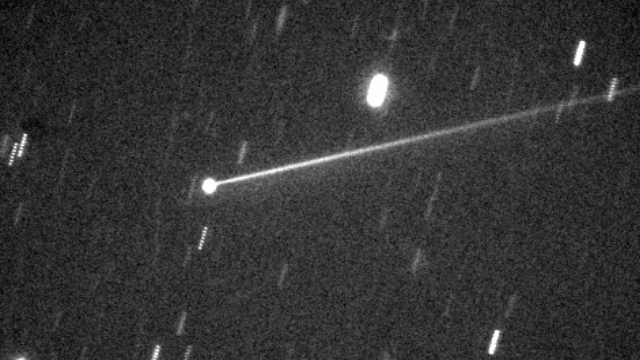Scientists continue to pore over the results of NASA’s stunningly successful DART test to deflect a harmless asteroid. As the latest findings suggest, the recoil created by the blast of debris spewing out from Dimorphos after impact was significant, further boosting the spacecraft’s influence on the asteroid.
NASA’s fridge-sized spacecraft smashed into the 163.07 m-long Dimorphos on September 26, shortening its orbit around its larger partner, Didymos, by a whopping 33 minutes. That equates to several dozen feet, demonstrating the feasibility of using kinetic impactors as a means to deflect threatening asteroids.
A stunning side-effect of the test were the gigantic and complex plumes that emanated from the asteroid after impact. The Didymos-Dimorphos system, located 11 million kilometres from Earth, even sprouted a long tail in the wake of the experiment. DART, short for Double Asteroid Redirection Test, had a profound impact on Dimorphos, kicking up a surprising amount of debris, or “ejecta,” in the parlance of planetary scientists.

Dimorphos, as we learned, is a rubble pile asteroid, as opposed to it being a dense, tightly packed rocky body. This undoubtedly contributed to the excessive amount of ejected debris, but scientists weren’t entirely sure how much debris the asteroid shed as a result of the impact. Preliminary findings presented on Thursday at the American Geophysical Union’s Fall Meeting in Chicago are casting new light on this and other aspects of the DART mission.
Not only did DART kick up tons of ejecta, it also triggered a recoil effect that further served to nudge the asteroid in the desired direction, as Andy Rivkin, DART investigation team lead, explained at the meeting. “We got a lot of bang for the buck,” he told BBC News.
Indeed, had Dimorphos been a more compact body, the same level of recoil likely wouldn’t have happened. “If you blast material off the target then you have a recoil force,” explained DART mission scientist Andy Cheng from the Johns Hopkins University Applied Physics Lab, who also spoke at the meeting. The resulting recoil is analogous to letting go of a balloon; as the air rushes out, it pushes the balloon in the opposite direction. In the case of Dimorphos, the stream of ejecta served as the air coming out of the balloon, which likewise pushed the asteroid in the opposite direction.
Planetary scientists are starting to get a sense as to how much debris got displaced. DART, travelling at 22,531 km per hour, struck with enough force to spill over 2 million pounds of material into the void. That’s enough to fill around six or seven rail cars, NASA said in a statement. That estimate might actually be on the low side, and the true figure could possibly be 10 times higher, Rivkin said at the meeting.
The scientists assigned DART’s momentum factor, known as “beta,” a value of 3.6, meaning that the momentum transferred into Dimorphos was 3.6 times greater than an impact event that produced no ejecta plume. “The result of that recoil force is that you put more momentum into the target, and you end up with a bigger deflection,” Cheng told reporters. “If you’re trying to save the Earth, this makes a big difference.”
That’s a good point, as those values will dictate the parameters for an actual mission to deflect a legitimately dangerous asteroid. Cheng and his colleagues will now use these results to infer the beta values of other asteroids, a task that will require a deeper understanding of an object’s density, composition, porosity, and other parameters. The scientists are also hoping to figure out the degree to which DART’s initial hit moved the asteroid and how much of its movement happened on account of the recoil.
The speakers also produced another figure — the length of the tail, or ejecta plume, that formed in the wake of the impact. According to Rivkin, Dimorophos sprouted a tail measuring 18,600 miles (30,000 km) long.
“Impacting the asteroid was just the start,” Tom Statler, the program scientist for DART and a presenter at the meeting, said in the statement. “Now we use the observations to study what these bodies are made of and how they were formed — as well as how to defend our planet should there ever be an asteroid headed our way.”
